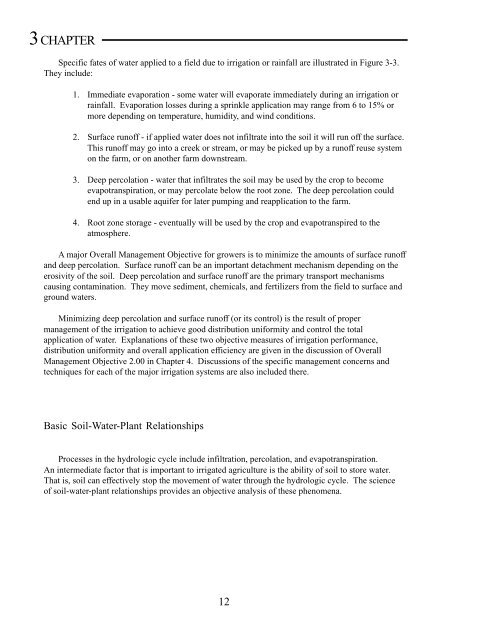Em4885 irrigation management practices to protect ground water
Em4885 irrigation management practices to protect ground water
Em4885 irrigation management practices to protect ground water
You also want an ePaper? Increase the reach of your titles
YUMPU automatically turns print PDFs into web optimized ePapers that Google loves.
3 CHAPTER<br />
Specific fates of <strong>water</strong> applied <strong>to</strong> a field due <strong>to</strong> <strong>irrigation</strong> or rainfall are illustrated in Figure 3-3.<br />
They include:<br />
1. Immediate evaporation - some <strong>water</strong> will evaporate immediately during an <strong>irrigation</strong> or<br />
rainfall. Evaporation losses during a sprinkle application may range from 6 <strong>to</strong> 15% or<br />
more depending on temperature, humidity, and wind conditions.<br />
2. Surface runoff - if applied <strong>water</strong> does not infiltrate in<strong>to</strong> the soil it will run off the surface.<br />
This runoff may go in<strong>to</strong> a creek or stream, or may be picked up by a runoff reuse system<br />
on the farm, or on another farm downstream.<br />
3. Deep percolation - <strong>water</strong> that infiltrates the soil may be used by the crop <strong>to</strong> become<br />
evapotranspiration, or may percolate below the root zone. The deep percolation could<br />
end up in a usable aquifer for later pumping and reapplication <strong>to</strong> the farm.<br />
4. Root zone s<strong>to</strong>rage - eventually will be used by the crop and evapotranspired <strong>to</strong> the<br />
atmosphere.<br />
A major Overall Management Objective for growers is <strong>to</strong> minimize the amounts of surface runoff<br />
and deep percolation. Surface runoff can be an important detachment mechanism depending on the<br />
erosivity of the soil. Deep percolation and surface runoff are the primary transport mechanisms<br />
causing contamination. They move sediment, chemicals, and fertilizers from the field <strong>to</strong> surface and<br />
<strong>ground</strong> <strong>water</strong>s.<br />
Minimizing deep percolation and surface runoff (or its control) is the result of proper<br />
<strong>management</strong> of the <strong>irrigation</strong> <strong>to</strong> achieve good distribution uniformity and control the <strong>to</strong>tal<br />
application of <strong>water</strong>. Explanations of these two objective measures of <strong>irrigation</strong> performance,<br />
distribution uniformity and overall application efficiency are given in the discussion of Overall<br />
Management Objective 2.00 in Chapter 4. Discussions of the specific <strong>management</strong> concerns and<br />
techniques for each of the major <strong>irrigation</strong> systems are also included there.<br />
Basic Soil-Water-Plant Relationships<br />
Processes in the hydrologic cycle include infiltration, percolation, and evapotranspiration.<br />
An intermediate fac<strong>to</strong>r that is important <strong>to</strong> irrigated agriculture is the ability of soil <strong>to</strong> s<strong>to</strong>re <strong>water</strong>.<br />
That is, soil can effectively s<strong>to</strong>p the movement of <strong>water</strong> through the hydrologic cycle. The science<br />
of soil-<strong>water</strong>-plant relationships provides an objective analysis of these phenomena.<br />
12
















